Leadership Report: Martin Luther King Jr. and the Selma March
VerifiedAdded on 2022/11/16
|20
|5474
|187
Report
AI Summary
This report provides an in-depth analysis of Martin Luther King Jr.'s leadership style, specifically focusing on his transformational approach during the Selma March. It explores King's key leadership traits, including self-confidence, determination, and love for the community, and examines how these qualities contributed to his success. The report also discusses the implications of his leadership style, such as his ability to inspire followers and translate his vision into concrete goals. Furthermore, it details how King led the protest, highlighting his strategic decisions and the impact of his nonviolent approach. The report concludes by emphasizing the overall effectiveness of King's leadership in the context of the civil rights movement and compares it to other leaders involved. It references leadership theories and provides insights into King's ability to cultivate people power and foster social change, making this a comprehensive study of his leadership.
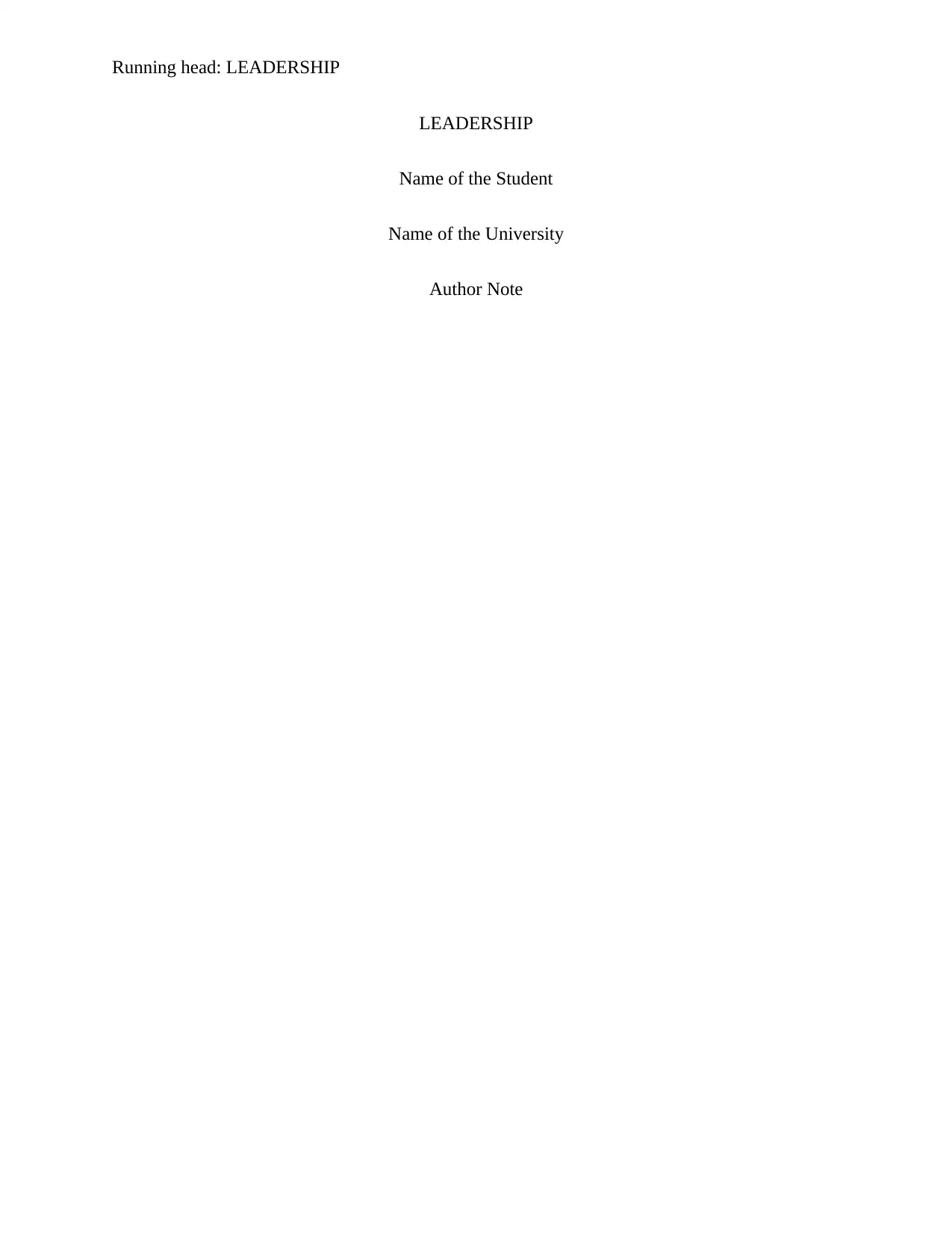
Running head: LEADERSHIP
LEADERSHIP
Name of the Student
Name of the University
Author Note
LEADERSHIP
Name of the Student
Name of the University
Author Note
Paraphrase This Document
Need a fresh take? Get an instant paraphrase of this document with our AI Paraphraser

1LEADERSHIP
EXECUTIVE SUMMARY
The following report attempted to shed light on the leadership style that was followed by the
celebrated leader, Martin Luther King Jr. The report discussed the transformational leadership
style as had been observed during the Selma March for the gain of the voting rights.
EXECUTIVE SUMMARY
The following report attempted to shed light on the leadership style that was followed by the
celebrated leader, Martin Luther King Jr. The report discussed the transformational leadership
style as had been observed during the Selma March for the gain of the voting rights.
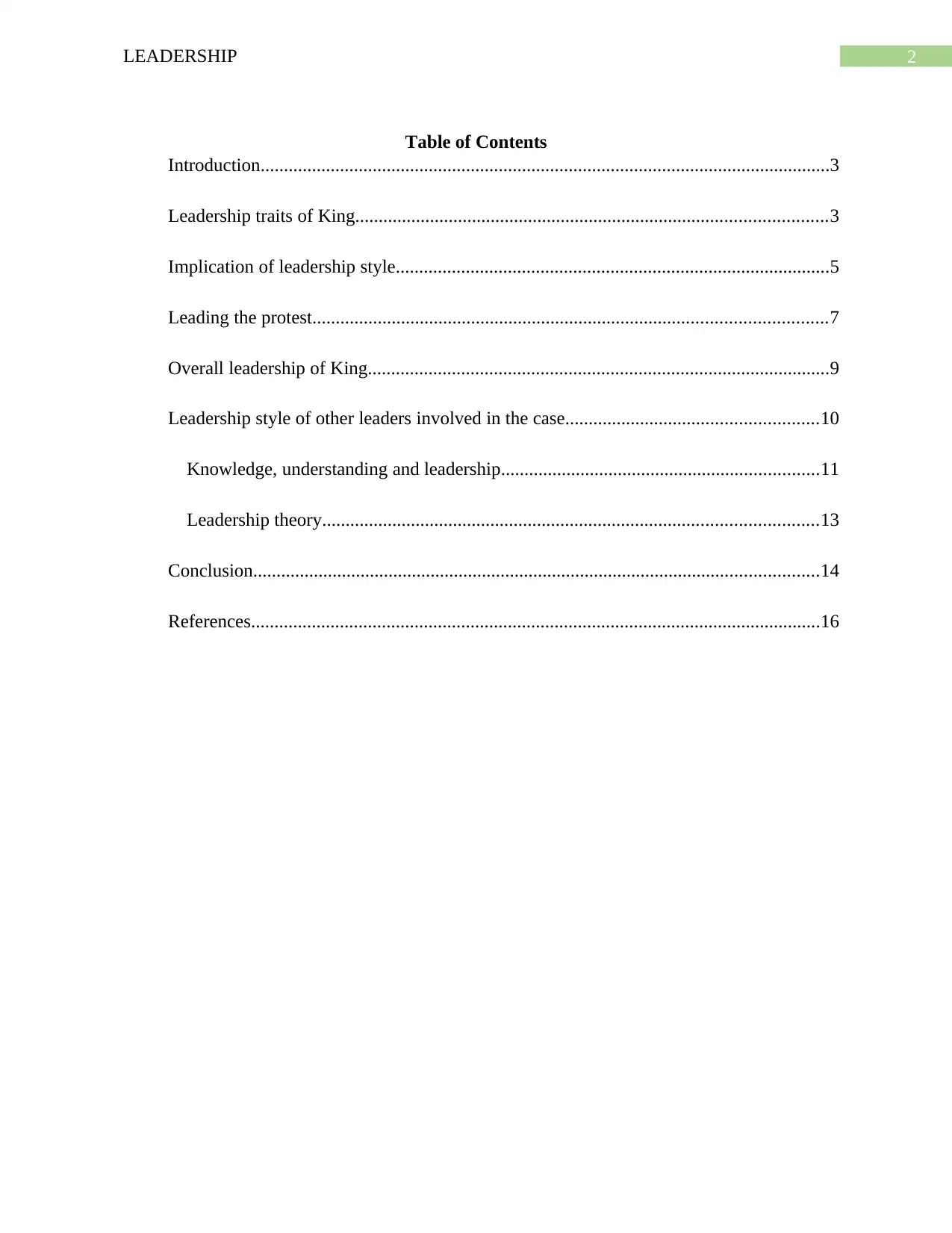
2LEADERSHIP
Table of Contents
Introduction..........................................................................................................................3
Leadership traits of King.....................................................................................................3
Implication of leadership style.............................................................................................5
Leading the protest..............................................................................................................7
Overall leadership of King...................................................................................................9
Leadership style of other leaders involved in the case......................................................10
Knowledge, understanding and leadership....................................................................11
Leadership theory..........................................................................................................13
Conclusion.........................................................................................................................14
References..........................................................................................................................16
Table of Contents
Introduction..........................................................................................................................3
Leadership traits of King.....................................................................................................3
Implication of leadership style.............................................................................................5
Leading the protest..............................................................................................................7
Overall leadership of King...................................................................................................9
Leadership style of other leaders involved in the case......................................................10
Knowledge, understanding and leadership....................................................................11
Leadership theory..........................................................................................................13
Conclusion.........................................................................................................................14
References..........................................................................................................................16
⊘ This is a preview!⊘
Do you want full access?
Subscribe today to unlock all pages.

Trusted by 1+ million students worldwide
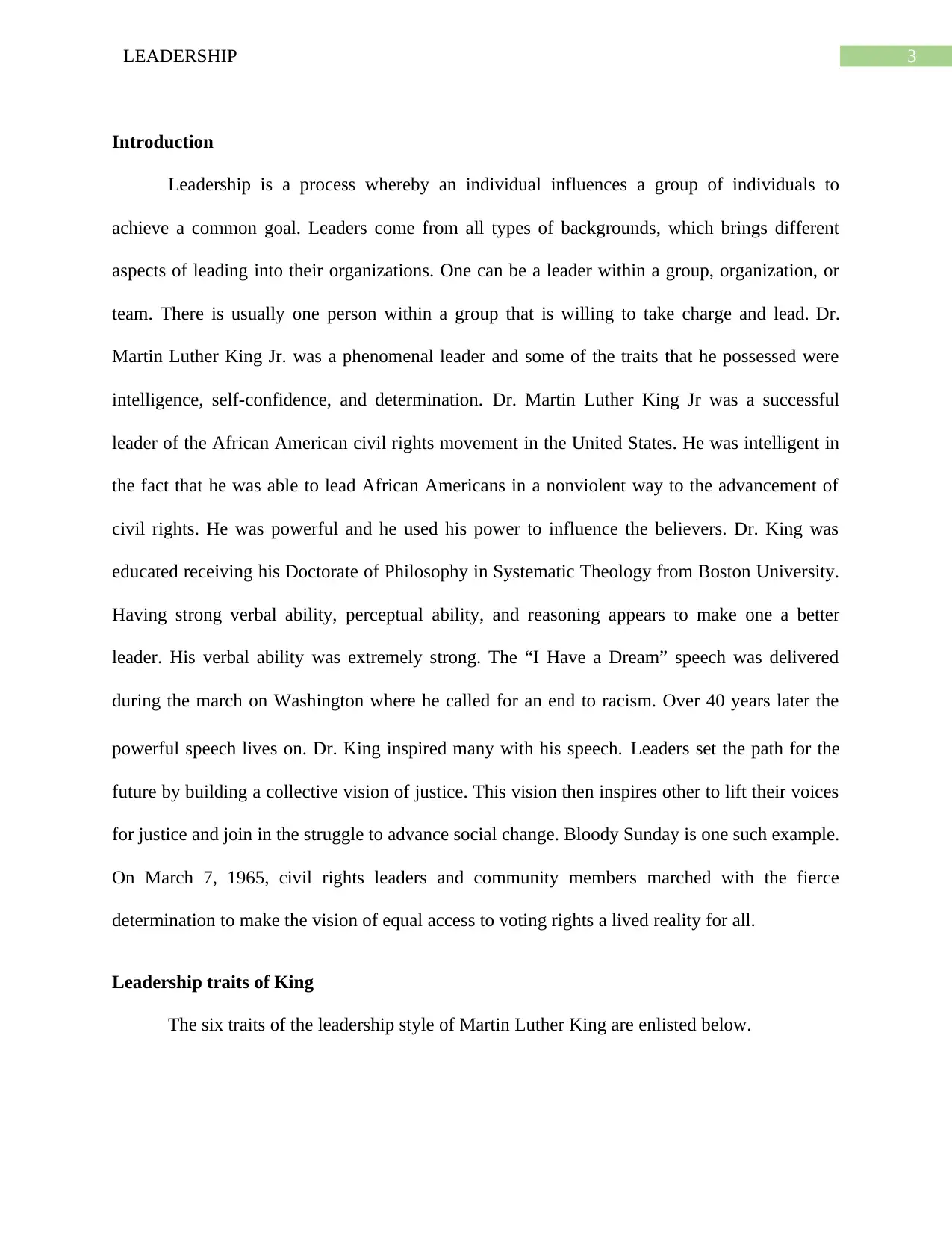
3LEADERSHIP
Introduction
Leadership is a process whereby an individual influences a group of individuals to
achieve a common goal. Leaders come from all types of backgrounds, which brings different
aspects of leading into their organizations. One can be a leader within a group, organization, or
team. There is usually one person within a group that is willing to take charge and lead. Dr.
Martin Luther King Jr. was a phenomenal leader and some of the traits that he possessed were
intelligence, self-confidence, and determination. Dr. Martin Luther King Jr was a successful
leader of the African American civil rights movement in the United States. He was intelligent in
the fact that he was able to lead African Americans in a nonviolent way to the advancement of
civil rights. He was powerful and he used his power to influence the believers. Dr. King was
educated receiving his Doctorate of Philosophy in Systematic Theology from Boston University.
Having strong verbal ability, perceptual ability, and reasoning appears to make one a better
leader. His verbal ability was extremely strong. The “I Have a Dream” speech was delivered
during the march on Washington where he called for an end to racism. Over 40 years later the
powerful speech lives on. Dr. King inspired many with his speech. Leaders set the path for the
future by building a collective vision of justice. This vision then inspires other to lift their voices
for justice and join in the struggle to advance social change. Bloody Sunday is one such example.
On March 7, 1965, civil rights leaders and community members marched with the fierce
determination to make the vision of equal access to voting rights a lived reality for all.
Leadership traits of King
The six traits of the leadership style of Martin Luther King are enlisted below.
Introduction
Leadership is a process whereby an individual influences a group of individuals to
achieve a common goal. Leaders come from all types of backgrounds, which brings different
aspects of leading into their organizations. One can be a leader within a group, organization, or
team. There is usually one person within a group that is willing to take charge and lead. Dr.
Martin Luther King Jr. was a phenomenal leader and some of the traits that he possessed were
intelligence, self-confidence, and determination. Dr. Martin Luther King Jr was a successful
leader of the African American civil rights movement in the United States. He was intelligent in
the fact that he was able to lead African Americans in a nonviolent way to the advancement of
civil rights. He was powerful and he used his power to influence the believers. Dr. King was
educated receiving his Doctorate of Philosophy in Systematic Theology from Boston University.
Having strong verbal ability, perceptual ability, and reasoning appears to make one a better
leader. His verbal ability was extremely strong. The “I Have a Dream” speech was delivered
during the march on Washington where he called for an end to racism. Over 40 years later the
powerful speech lives on. Dr. King inspired many with his speech. Leaders set the path for the
future by building a collective vision of justice. This vision then inspires other to lift their voices
for justice and join in the struggle to advance social change. Bloody Sunday is one such example.
On March 7, 1965, civil rights leaders and community members marched with the fierce
determination to make the vision of equal access to voting rights a lived reality for all.
Leadership traits of King
The six traits of the leadership style of Martin Luther King are enlisted below.
Paraphrase This Document
Need a fresh take? Get an instant paraphrase of this document with our AI Paraphraser
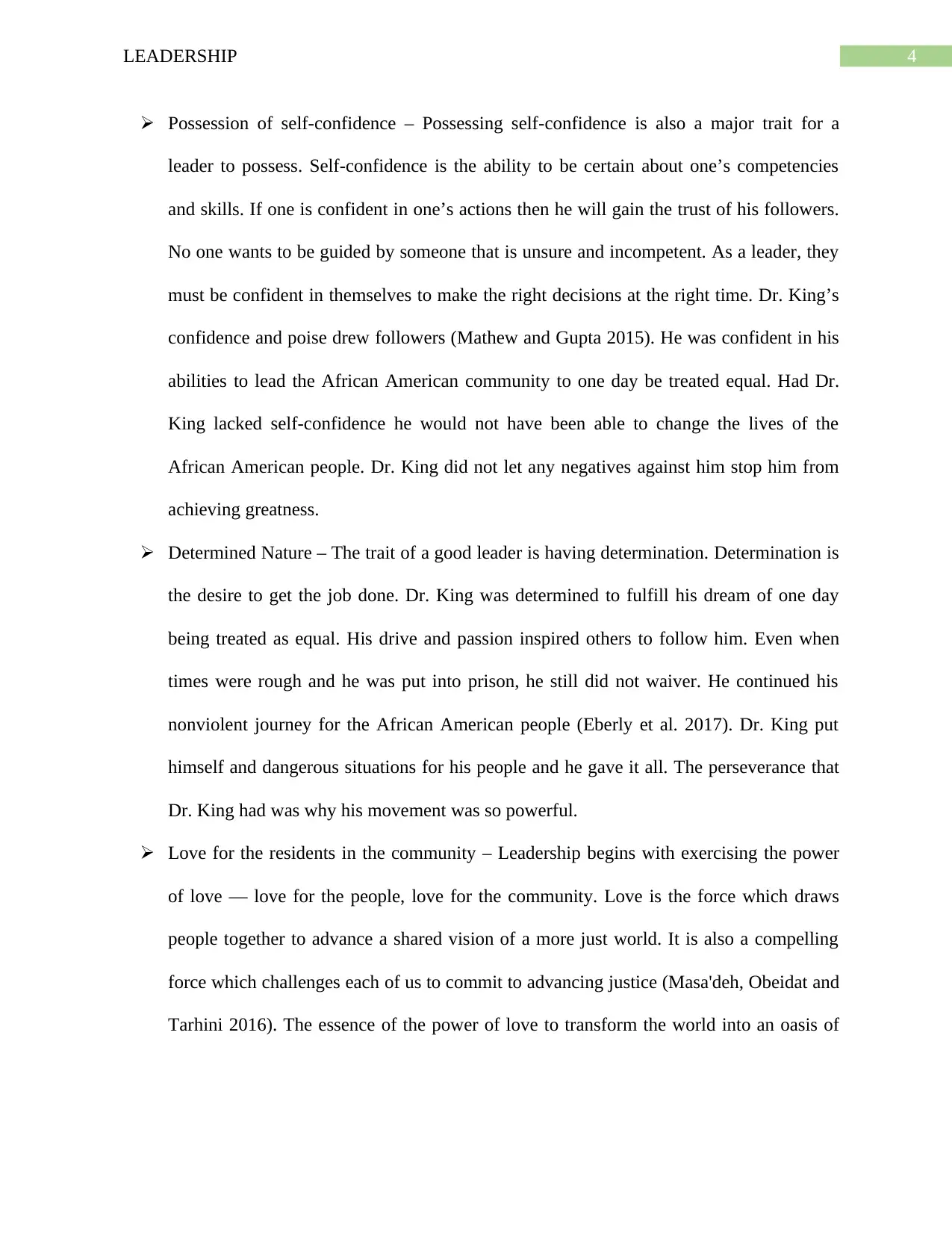
4LEADERSHIP
Possession of self-confidence – Possessing self-confidence is also a major trait for a
leader to possess. Self-confidence is the ability to be certain about one’s competencies
and skills. If one is confident in one’s actions then he will gain the trust of his followers.
No one wants to be guided by someone that is unsure and incompetent. As a leader, they
must be confident in themselves to make the right decisions at the right time. Dr. King’s
confidence and poise drew followers (Mathew and Gupta 2015). He was confident in his
abilities to lead the African American community to one day be treated equal. Had Dr.
King lacked self-confidence he would not have been able to change the lives of the
African American people. Dr. King did not let any negatives against him stop him from
achieving greatness.
Determined Nature – The trait of a good leader is having determination. Determination is
the desire to get the job done. Dr. King was determined to fulfill his dream of one day
being treated as equal. His drive and passion inspired others to follow him. Even when
times were rough and he was put into prison, he still did not waiver. He continued his
nonviolent journey for the African American people (Eberly et al. 2017). Dr. King put
himself and dangerous situations for his people and he gave it all. The perseverance that
Dr. King had was why his movement was so powerful.
Love for the residents in the community – Leadership begins with exercising the power
of love — love for the people, love for the community. Love is the force which draws
people together to advance a shared vision of a more just world. It is also a compelling
force which challenges each of us to commit to advancing justice (Masa'deh, Obeidat and
Tarhini 2016). The essence of the power of love to transform the world into an oasis of
Possession of self-confidence – Possessing self-confidence is also a major trait for a
leader to possess. Self-confidence is the ability to be certain about one’s competencies
and skills. If one is confident in one’s actions then he will gain the trust of his followers.
No one wants to be guided by someone that is unsure and incompetent. As a leader, they
must be confident in themselves to make the right decisions at the right time. Dr. King’s
confidence and poise drew followers (Mathew and Gupta 2015). He was confident in his
abilities to lead the African American community to one day be treated equal. Had Dr.
King lacked self-confidence he would not have been able to change the lives of the
African American people. Dr. King did not let any negatives against him stop him from
achieving greatness.
Determined Nature – The trait of a good leader is having determination. Determination is
the desire to get the job done. Dr. King was determined to fulfill his dream of one day
being treated as equal. His drive and passion inspired others to follow him. Even when
times were rough and he was put into prison, he still did not waiver. He continued his
nonviolent journey for the African American people (Eberly et al. 2017). Dr. King put
himself and dangerous situations for his people and he gave it all. The perseverance that
Dr. King had was why his movement was so powerful.
Love for the residents in the community – Leadership begins with exercising the power
of love — love for the people, love for the community. Love is the force which draws
people together to advance a shared vision of a more just world. It is also a compelling
force which challenges each of us to commit to advancing justice (Masa'deh, Obeidat and
Tarhini 2016). The essence of the power of love to transform the world into an oasis of
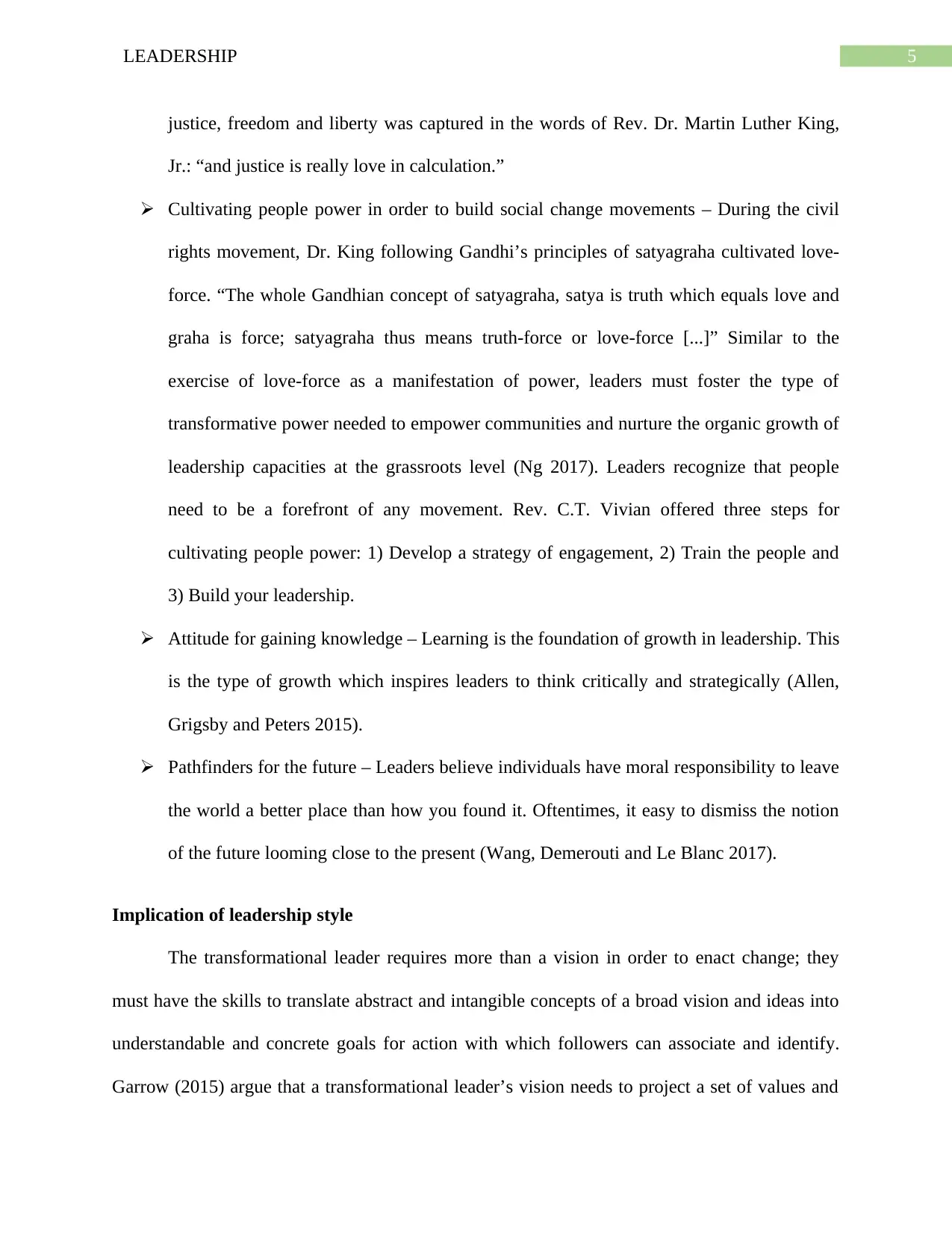
5LEADERSHIP
justice, freedom and liberty was captured in the words of Rev. Dr. Martin Luther King,
Jr.: “and justice is really love in calculation.”
Cultivating people power in order to build social change movements – During the civil
rights movement, Dr. King following Gandhi’s principles of satyagraha cultivated love-
force. “The whole Gandhian concept of satyagraha, satya is truth which equals love and
graha is force; satyagraha thus means truth-force or love-force [...]” Similar to the
exercise of love-force as a manifestation of power, leaders must foster the type of
transformative power needed to empower communities and nurture the organic growth of
leadership capacities at the grassroots level (Ng 2017). Leaders recognize that people
need to be a forefront of any movement. Rev. C.T. Vivian offered three steps for
cultivating people power: 1) Develop a strategy of engagement, 2) Train the people and
3) Build your leadership.
Attitude for gaining knowledge – Learning is the foundation of growth in leadership. This
is the type of growth which inspires leaders to think critically and strategically (Allen,
Grigsby and Peters 2015).
Pathfinders for the future – Leaders believe individuals have moral responsibility to leave
the world a better place than how you found it. Oftentimes, it easy to dismiss the notion
of the future looming close to the present (Wang, Demerouti and Le Blanc 2017).
Implication of leadership style
The transformational leader requires more than a vision in order to enact change; they
must have the skills to translate abstract and intangible concepts of a broad vision and ideas into
understandable and concrete goals for action with which followers can associate and identify.
Garrow (2015) argue that a transformational leader’s vision needs to project a set of values and
justice, freedom and liberty was captured in the words of Rev. Dr. Martin Luther King,
Jr.: “and justice is really love in calculation.”
Cultivating people power in order to build social change movements – During the civil
rights movement, Dr. King following Gandhi’s principles of satyagraha cultivated love-
force. “The whole Gandhian concept of satyagraha, satya is truth which equals love and
graha is force; satyagraha thus means truth-force or love-force [...]” Similar to the
exercise of love-force as a manifestation of power, leaders must foster the type of
transformative power needed to empower communities and nurture the organic growth of
leadership capacities at the grassroots level (Ng 2017). Leaders recognize that people
need to be a forefront of any movement. Rev. C.T. Vivian offered three steps for
cultivating people power: 1) Develop a strategy of engagement, 2) Train the people and
3) Build your leadership.
Attitude for gaining knowledge – Learning is the foundation of growth in leadership. This
is the type of growth which inspires leaders to think critically and strategically (Allen,
Grigsby and Peters 2015).
Pathfinders for the future – Leaders believe individuals have moral responsibility to leave
the world a better place than how you found it. Oftentimes, it easy to dismiss the notion
of the future looming close to the present (Wang, Demerouti and Le Blanc 2017).
Implication of leadership style
The transformational leader requires more than a vision in order to enact change; they
must have the skills to translate abstract and intangible concepts of a broad vision and ideas into
understandable and concrete goals for action with which followers can associate and identify.
Garrow (2015) argue that a transformational leader’s vision needs to project a set of values and
⊘ This is a preview!⊘
Do you want full access?
Subscribe today to unlock all pages.

Trusted by 1+ million students worldwide
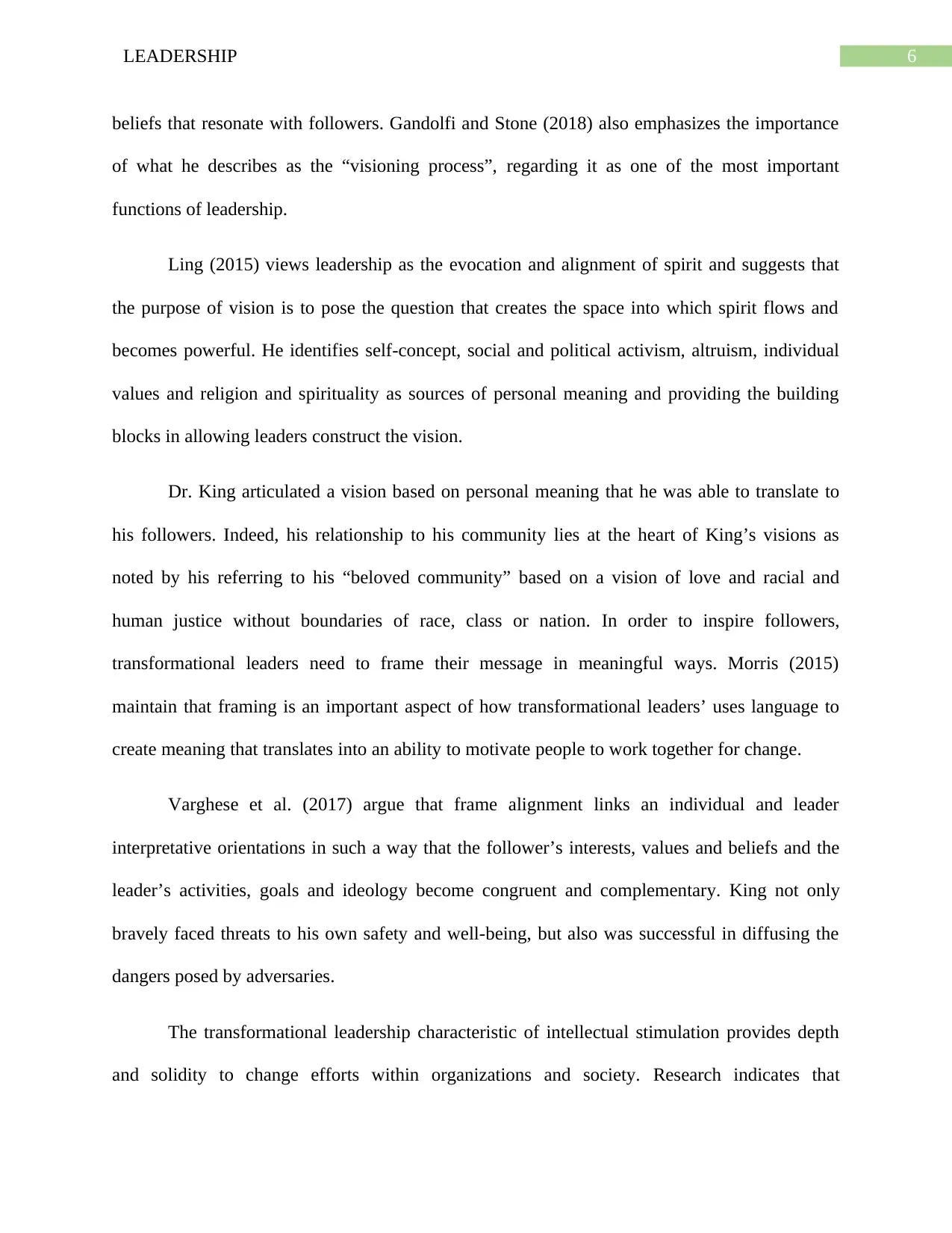
6LEADERSHIP
beliefs that resonate with followers. Gandolfi and Stone (2018) also emphasizes the importance
of what he describes as the “visioning process”, regarding it as one of the most important
functions of leadership.
Ling (2015) views leadership as the evocation and alignment of spirit and suggests that
the purpose of vision is to pose the question that creates the space into which spirit flows and
becomes powerful. He identifies self-concept, social and political activism, altruism, individual
values and religion and spirituality as sources of personal meaning and providing the building
blocks in allowing leaders construct the vision.
Dr. King articulated a vision based on personal meaning that he was able to translate to
his followers. Indeed, his relationship to his community lies at the heart of King’s visions as
noted by his referring to his “beloved community” based on a vision of love and racial and
human justice without boundaries of race, class or nation. In order to inspire followers,
transformational leaders need to frame their message in meaningful ways. Morris (2015)
maintain that framing is an important aspect of how transformational leaders’ uses language to
create meaning that translates into an ability to motivate people to work together for change.
Varghese et al. (2017) argue that frame alignment links an individual and leader
interpretative orientations in such a way that the follower’s interests, values and beliefs and the
leader’s activities, goals and ideology become congruent and complementary. King not only
bravely faced threats to his own safety and well-being, but also was successful in diffusing the
dangers posed by adversaries.
The transformational leadership characteristic of intellectual stimulation provides depth
and solidity to change efforts within organizations and society. Research indicates that
beliefs that resonate with followers. Gandolfi and Stone (2018) also emphasizes the importance
of what he describes as the “visioning process”, regarding it as one of the most important
functions of leadership.
Ling (2015) views leadership as the evocation and alignment of spirit and suggests that
the purpose of vision is to pose the question that creates the space into which spirit flows and
becomes powerful. He identifies self-concept, social and political activism, altruism, individual
values and religion and spirituality as sources of personal meaning and providing the building
blocks in allowing leaders construct the vision.
Dr. King articulated a vision based on personal meaning that he was able to translate to
his followers. Indeed, his relationship to his community lies at the heart of King’s visions as
noted by his referring to his “beloved community” based on a vision of love and racial and
human justice without boundaries of race, class or nation. In order to inspire followers,
transformational leaders need to frame their message in meaningful ways. Morris (2015)
maintain that framing is an important aspect of how transformational leaders’ uses language to
create meaning that translates into an ability to motivate people to work together for change.
Varghese et al. (2017) argue that frame alignment links an individual and leader
interpretative orientations in such a way that the follower’s interests, values and beliefs and the
leader’s activities, goals and ideology become congruent and complementary. King not only
bravely faced threats to his own safety and well-being, but also was successful in diffusing the
dangers posed by adversaries.
The transformational leadership characteristic of intellectual stimulation provides depth
and solidity to change efforts within organizations and society. Research indicates that
Paraphrase This Document
Need a fresh take? Get an instant paraphrase of this document with our AI Paraphraser
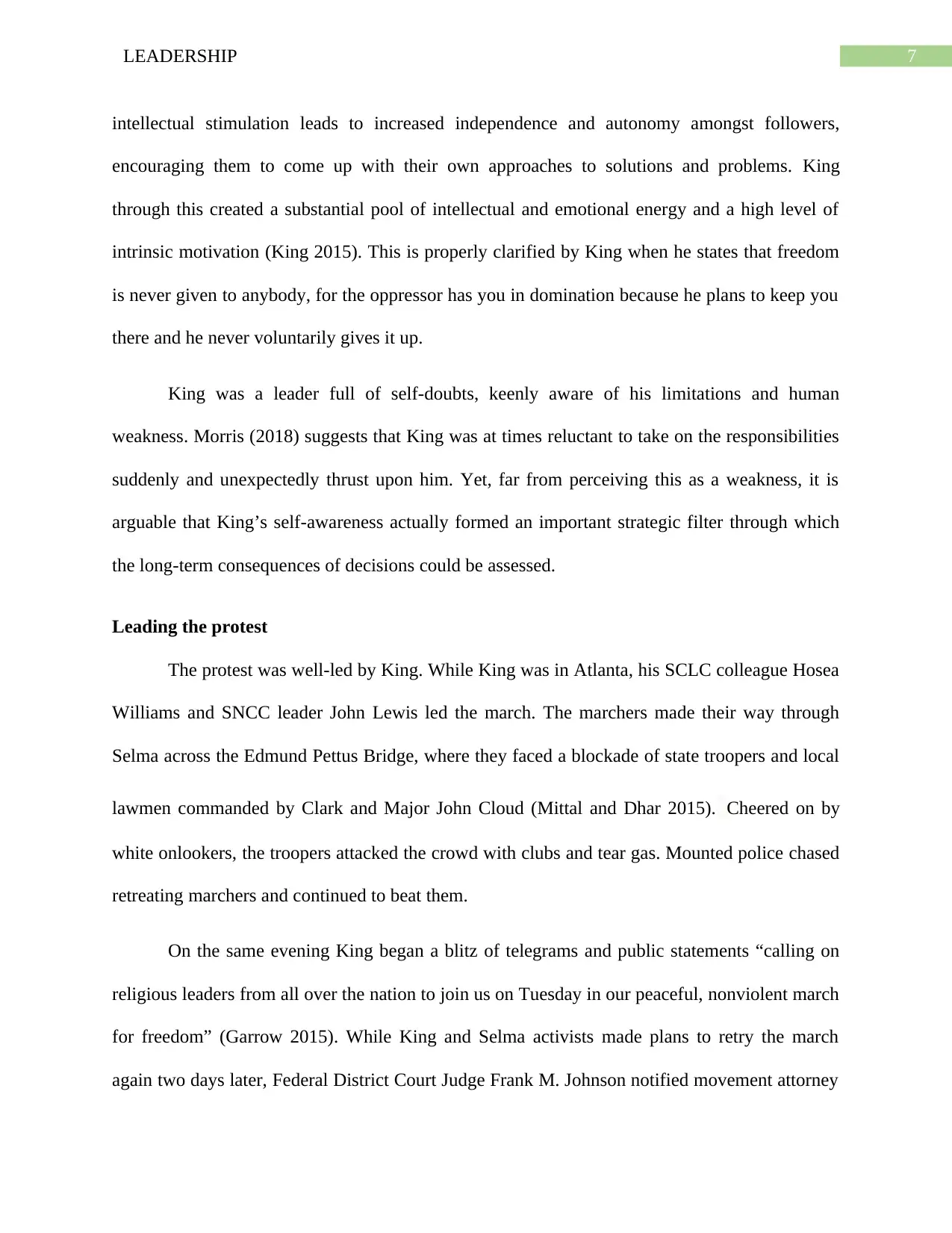
7LEADERSHIP
intellectual stimulation leads to increased independence and autonomy amongst followers,
encouraging them to come up with their own approaches to solutions and problems. King
through this created a substantial pool of intellectual and emotional energy and a high level of
intrinsic motivation (King 2015). This is properly clarified by King when he states that freedom
is never given to anybody, for the oppressor has you in domination because he plans to keep you
there and he never voluntarily gives it up.
King was a leader full of self-doubts, keenly aware of his limitations and human
weakness. Morris (2018) suggests that King was at times reluctant to take on the responsibilities
suddenly and unexpectedly thrust upon him. Yet, far from perceiving this as a weakness, it is
arguable that King’s self-awareness actually formed an important strategic filter through which
the long-term consequences of decisions could be assessed.
Leading the protest
The protest was well-led by King. While King was in Atlanta, his SCLC colleague Hosea
Williams and SNCC leader John Lewis led the march. The marchers made their way through
Selma across the Edmund Pettus Bridge, where they faced a blockade of state troopers and local
lawmen commanded by Clark and Major John Cloud (Mittal and Dhar 2015). Cheered on by
white onlookers, the troopers attacked the crowd with clubs and tear gas. Mounted police chased
retreating marchers and continued to beat them.
On the same evening King began a blitz of telegrams and public statements “calling on
religious leaders from all over the nation to join us on Tuesday in our peaceful, nonviolent march
for freedom” (Garrow 2015). While King and Selma activists made plans to retry the march
again two days later, Federal District Court Judge Frank M. Johnson notified movement attorney
intellectual stimulation leads to increased independence and autonomy amongst followers,
encouraging them to come up with their own approaches to solutions and problems. King
through this created a substantial pool of intellectual and emotional energy and a high level of
intrinsic motivation (King 2015). This is properly clarified by King when he states that freedom
is never given to anybody, for the oppressor has you in domination because he plans to keep you
there and he never voluntarily gives it up.
King was a leader full of self-doubts, keenly aware of his limitations and human
weakness. Morris (2018) suggests that King was at times reluctant to take on the responsibilities
suddenly and unexpectedly thrust upon him. Yet, far from perceiving this as a weakness, it is
arguable that King’s self-awareness actually formed an important strategic filter through which
the long-term consequences of decisions could be assessed.
Leading the protest
The protest was well-led by King. While King was in Atlanta, his SCLC colleague Hosea
Williams and SNCC leader John Lewis led the march. The marchers made their way through
Selma across the Edmund Pettus Bridge, where they faced a blockade of state troopers and local
lawmen commanded by Clark and Major John Cloud (Mittal and Dhar 2015). Cheered on by
white onlookers, the troopers attacked the crowd with clubs and tear gas. Mounted police chased
retreating marchers and continued to beat them.
On the same evening King began a blitz of telegrams and public statements “calling on
religious leaders from all over the nation to join us on Tuesday in our peaceful, nonviolent march
for freedom” (Garrow 2015). While King and Selma activists made plans to retry the march
again two days later, Federal District Court Judge Frank M. Johnson notified movement attorney
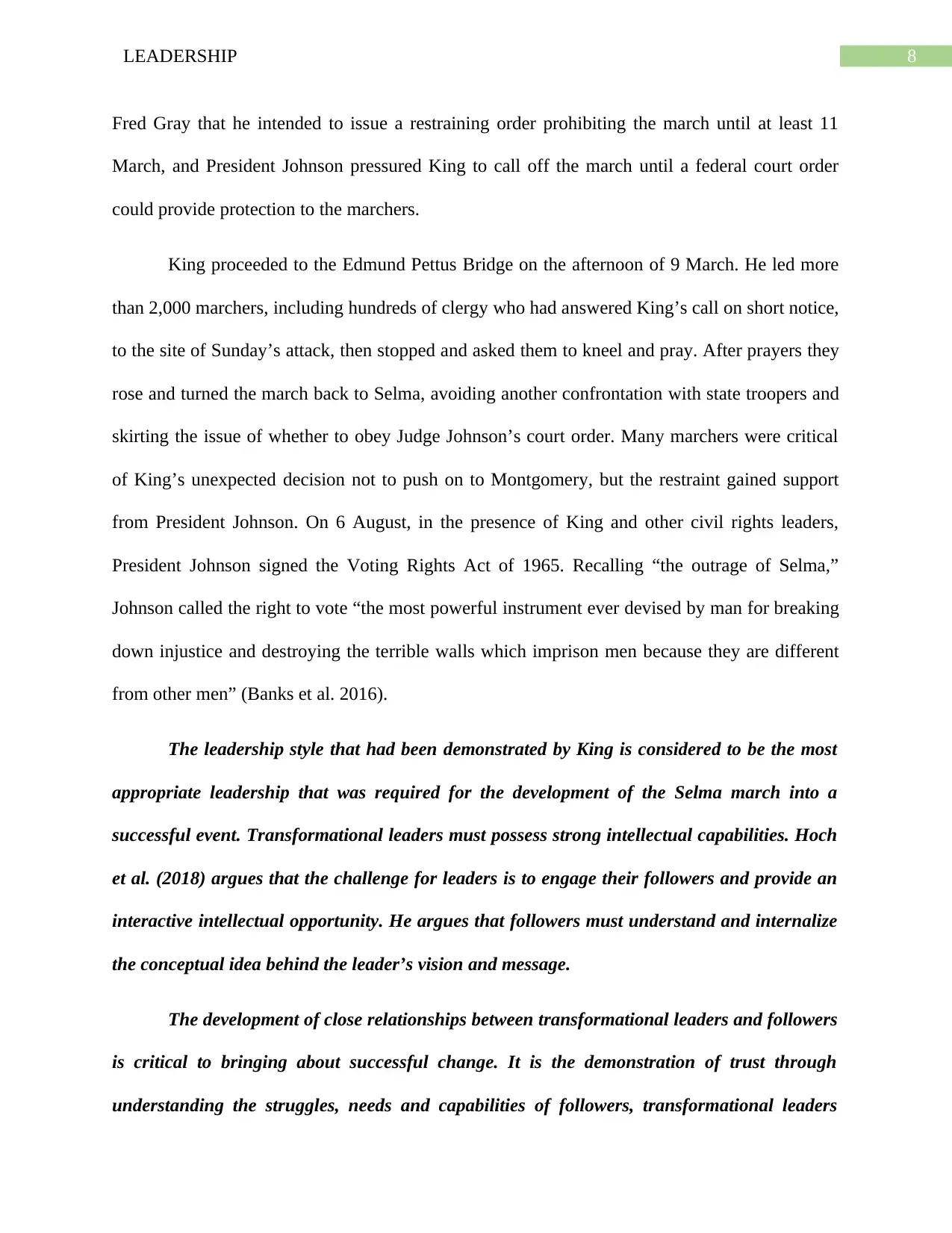
8LEADERSHIP
Fred Gray that he intended to issue a restraining order prohibiting the march until at least 11
March, and President Johnson pressured King to call off the march until a federal court order
could provide protection to the marchers.
King proceeded to the Edmund Pettus Bridge on the afternoon of 9 March. He led more
than 2,000 marchers, including hundreds of clergy who had answered King’s call on short notice,
to the site of Sunday’s attack, then stopped and asked them to kneel and pray. After prayers they
rose and turned the march back to Selma, avoiding another confrontation with state troopers and
skirting the issue of whether to obey Judge Johnson’s court order. Many marchers were critical
of King’s unexpected decision not to push on to Montgomery, but the restraint gained support
from President Johnson. On 6 August, in the presence of King and other civil rights leaders,
President Johnson signed the Voting Rights Act of 1965. Recalling “the outrage of Selma,”
Johnson called the right to vote “the most powerful instrument ever devised by man for breaking
down injustice and destroying the terrible walls which imprison men because they are different
from other men” (Banks et al. 2016).
The leadership style that had been demonstrated by King is considered to be the most
appropriate leadership that was required for the development of the Selma march into a
successful event. Transformational leaders must possess strong intellectual capabilities. Hoch
et al. (2018) argues that the challenge for leaders is to engage their followers and provide an
interactive intellectual opportunity. He argues that followers must understand and internalize
the conceptual idea behind the leader’s vision and message.
The development of close relationships between transformational leaders and followers
is critical to bringing about successful change. It is the demonstration of trust through
understanding the struggles, needs and capabilities of followers, transformational leaders
Fred Gray that he intended to issue a restraining order prohibiting the march until at least 11
March, and President Johnson pressured King to call off the march until a federal court order
could provide protection to the marchers.
King proceeded to the Edmund Pettus Bridge on the afternoon of 9 March. He led more
than 2,000 marchers, including hundreds of clergy who had answered King’s call on short notice,
to the site of Sunday’s attack, then stopped and asked them to kneel and pray. After prayers they
rose and turned the march back to Selma, avoiding another confrontation with state troopers and
skirting the issue of whether to obey Judge Johnson’s court order. Many marchers were critical
of King’s unexpected decision not to push on to Montgomery, but the restraint gained support
from President Johnson. On 6 August, in the presence of King and other civil rights leaders,
President Johnson signed the Voting Rights Act of 1965. Recalling “the outrage of Selma,”
Johnson called the right to vote “the most powerful instrument ever devised by man for breaking
down injustice and destroying the terrible walls which imprison men because they are different
from other men” (Banks et al. 2016).
The leadership style that had been demonstrated by King is considered to be the most
appropriate leadership that was required for the development of the Selma march into a
successful event. Transformational leaders must possess strong intellectual capabilities. Hoch
et al. (2018) argues that the challenge for leaders is to engage their followers and provide an
interactive intellectual opportunity. He argues that followers must understand and internalize
the conceptual idea behind the leader’s vision and message.
The development of close relationships between transformational leaders and followers
is critical to bringing about successful change. It is the demonstration of trust through
understanding the struggles, needs and capabilities of followers, transformational leaders
⊘ This is a preview!⊘
Do you want full access?
Subscribe today to unlock all pages.

Trusted by 1+ million students worldwide
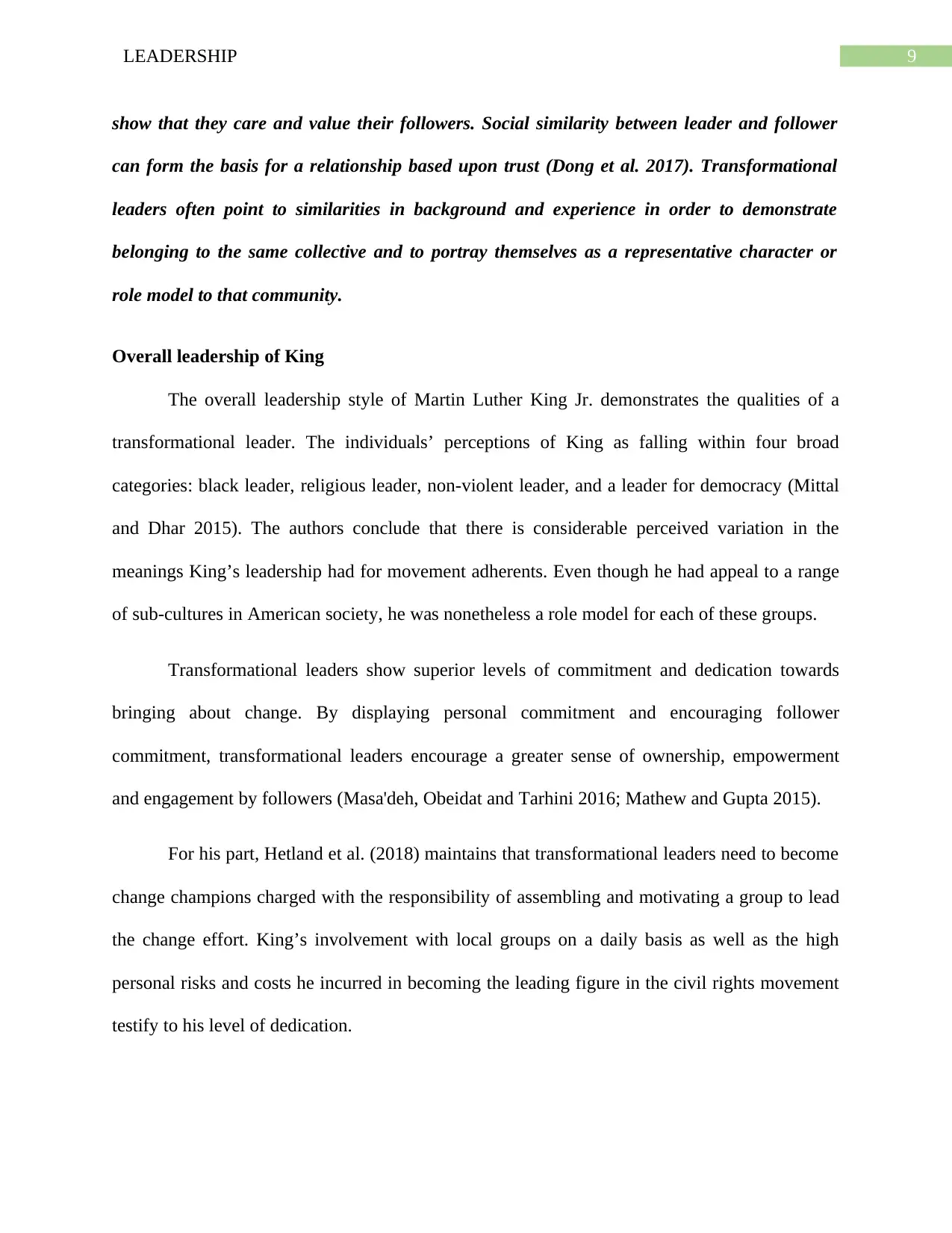
9LEADERSHIP
show that they care and value their followers. Social similarity between leader and follower
can form the basis for a relationship based upon trust (Dong et al. 2017). Transformational
leaders often point to similarities in background and experience in order to demonstrate
belonging to the same collective and to portray themselves as a representative character or
role model to that community.
Overall leadership of King
The overall leadership style of Martin Luther King Jr. demonstrates the qualities of a
transformational leader. The individuals’ perceptions of King as falling within four broad
categories: black leader, religious leader, non-violent leader, and a leader for democracy (Mittal
and Dhar 2015). The authors conclude that there is considerable perceived variation in the
meanings King’s leadership had for movement adherents. Even though he had appeal to a range
of sub-cultures in American society, he was nonetheless a role model for each of these groups.
Transformational leaders show superior levels of commitment and dedication towards
bringing about change. By displaying personal commitment and encouraging follower
commitment, transformational leaders encourage a greater sense of ownership, empowerment
and engagement by followers (Masa'deh, Obeidat and Tarhini 2016; Mathew and Gupta 2015).
For his part, Hetland et al. (2018) maintains that transformational leaders need to become
change champions charged with the responsibility of assembling and motivating a group to lead
the change effort. King’s involvement with local groups on a daily basis as well as the high
personal risks and costs he incurred in becoming the leading figure in the civil rights movement
testify to his level of dedication.
show that they care and value their followers. Social similarity between leader and follower
can form the basis for a relationship based upon trust (Dong et al. 2017). Transformational
leaders often point to similarities in background and experience in order to demonstrate
belonging to the same collective and to portray themselves as a representative character or
role model to that community.
Overall leadership of King
The overall leadership style of Martin Luther King Jr. demonstrates the qualities of a
transformational leader. The individuals’ perceptions of King as falling within four broad
categories: black leader, religious leader, non-violent leader, and a leader for democracy (Mittal
and Dhar 2015). The authors conclude that there is considerable perceived variation in the
meanings King’s leadership had for movement adherents. Even though he had appeal to a range
of sub-cultures in American society, he was nonetheless a role model for each of these groups.
Transformational leaders show superior levels of commitment and dedication towards
bringing about change. By displaying personal commitment and encouraging follower
commitment, transformational leaders encourage a greater sense of ownership, empowerment
and engagement by followers (Masa'deh, Obeidat and Tarhini 2016; Mathew and Gupta 2015).
For his part, Hetland et al. (2018) maintains that transformational leaders need to become
change champions charged with the responsibility of assembling and motivating a group to lead
the change effort. King’s involvement with local groups on a daily basis as well as the high
personal risks and costs he incurred in becoming the leading figure in the civil rights movement
testify to his level of dedication.
Paraphrase This Document
Need a fresh take? Get an instant paraphrase of this document with our AI Paraphraser
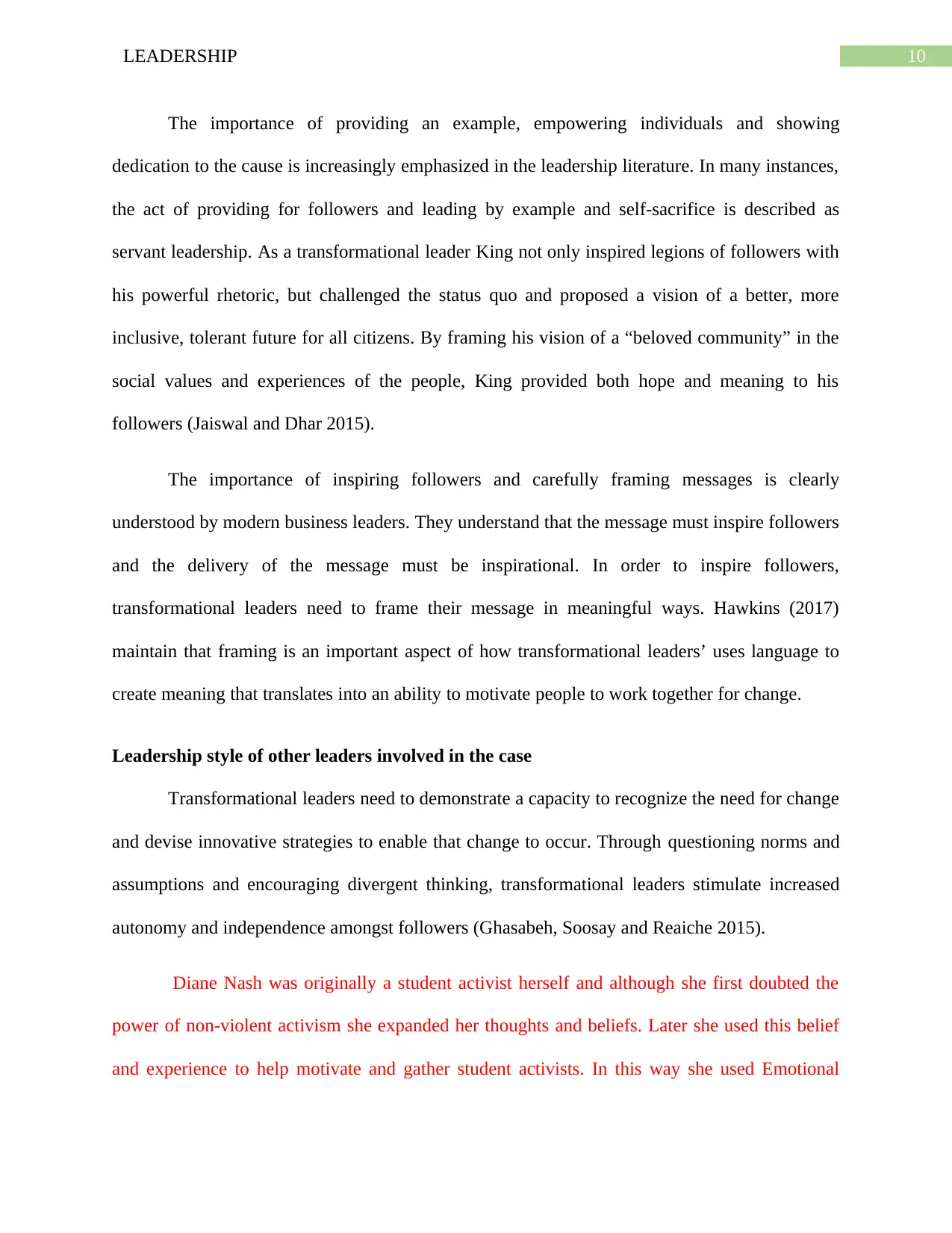
10LEADERSHIP
The importance of providing an example, empowering individuals and showing
dedication to the cause is increasingly emphasized in the leadership literature. In many instances,
the act of providing for followers and leading by example and self-sacrifice is described as
servant leadership. As a transformational leader King not only inspired legions of followers with
his powerful rhetoric, but challenged the status quo and proposed a vision of a better, more
inclusive, tolerant future for all citizens. By framing his vision of a “beloved community” in the
social values and experiences of the people, King provided both hope and meaning to his
followers (Jaiswal and Dhar 2015).
The importance of inspiring followers and carefully framing messages is clearly
understood by modern business leaders. They understand that the message must inspire followers
and the delivery of the message must be inspirational. In order to inspire followers,
transformational leaders need to frame their message in meaningful ways. Hawkins (2017)
maintain that framing is an important aspect of how transformational leaders’ uses language to
create meaning that translates into an ability to motivate people to work together for change.
Leadership style of other leaders involved in the case
Transformational leaders need to demonstrate a capacity to recognize the need for change
and devise innovative strategies to enable that change to occur. Through questioning norms and
assumptions and encouraging divergent thinking, transformational leaders stimulate increased
autonomy and independence amongst followers (Ghasabeh, Soosay and Reaiche 2015).
Diane Nash was originally a student activist herself and although she first doubted the
power of non-violent activism she expanded her thoughts and beliefs. Later she used this belief
and experience to help motivate and gather student activists. In this way she used Emotional
The importance of providing an example, empowering individuals and showing
dedication to the cause is increasingly emphasized in the leadership literature. In many instances,
the act of providing for followers and leading by example and self-sacrifice is described as
servant leadership. As a transformational leader King not only inspired legions of followers with
his powerful rhetoric, but challenged the status quo and proposed a vision of a better, more
inclusive, tolerant future for all citizens. By framing his vision of a “beloved community” in the
social values and experiences of the people, King provided both hope and meaning to his
followers (Jaiswal and Dhar 2015).
The importance of inspiring followers and carefully framing messages is clearly
understood by modern business leaders. They understand that the message must inspire followers
and the delivery of the message must be inspirational. In order to inspire followers,
transformational leaders need to frame their message in meaningful ways. Hawkins (2017)
maintain that framing is an important aspect of how transformational leaders’ uses language to
create meaning that translates into an ability to motivate people to work together for change.
Leadership style of other leaders involved in the case
Transformational leaders need to demonstrate a capacity to recognize the need for change
and devise innovative strategies to enable that change to occur. Through questioning norms and
assumptions and encouraging divergent thinking, transformational leaders stimulate increased
autonomy and independence amongst followers (Ghasabeh, Soosay and Reaiche 2015).
Diane Nash was originally a student activist herself and although she first doubted the
power of non-violent activism she expanded her thoughts and beliefs. Later she used this belief
and experience to help motivate and gather student activists. In this way she used Emotional
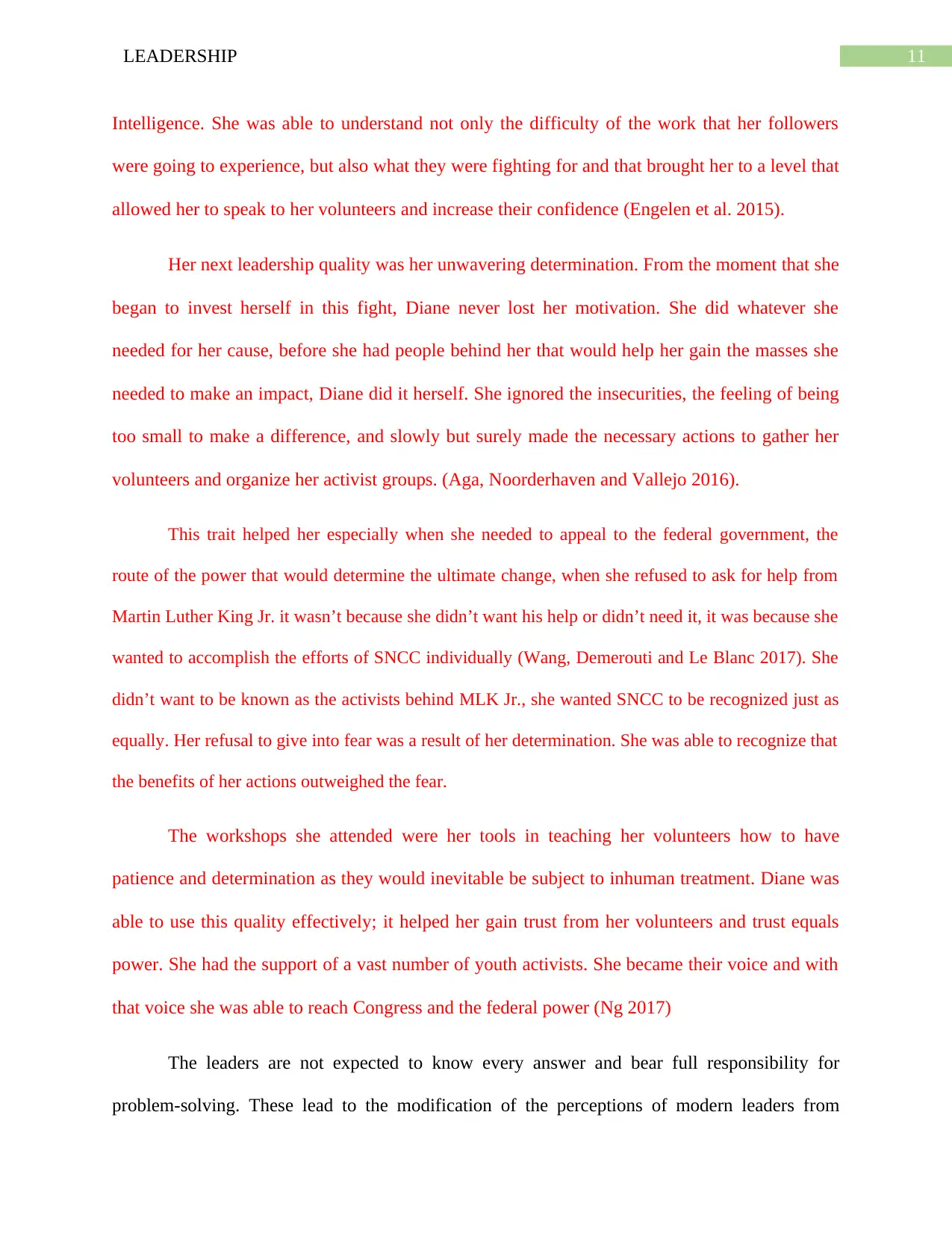
11LEADERSHIP
Intelligence. She was able to understand not only the difficulty of the work that her followers
were going to experience, but also what they were fighting for and that brought her to a level that
allowed her to speak to her volunteers and increase their confidence (Engelen et al. 2015).
Her next leadership quality was her unwavering determination. From the moment that she
began to invest herself in this fight, Diane never lost her motivation. She did whatever she
needed for her cause, before she had people behind her that would help her gain the masses she
needed to make an impact, Diane did it herself. She ignored the insecurities, the feeling of being
too small to make a difference, and slowly but surely made the necessary actions to gather her
volunteers and organize her activist groups. (Aga, Noorderhaven and Vallejo 2016).
This trait helped her especially when she needed to appeal to the federal government, the
route of the power that would determine the ultimate change, when she refused to ask for help from
Martin Luther King Jr. it wasn’t because she didn’t want his help or didn’t need it, it was because she
wanted to accomplish the efforts of SNCC individually (Wang, Demerouti and Le Blanc 2017). She
didn’t want to be known as the activists behind MLK Jr., she wanted SNCC to be recognized just as
equally. Her refusal to give into fear was a result of her determination. She was able to recognize that
the benefits of her actions outweighed the fear.
The workshops she attended were her tools in teaching her volunteers how to have
patience and determination as they would inevitable be subject to inhuman treatment. Diane was
able to use this quality effectively; it helped her gain trust from her volunteers and trust equals
power. She had the support of a vast number of youth activists. She became their voice and with
that voice she was able to reach Congress and the federal power (Ng 2017)
The leaders are not expected to know every answer and bear full responsibility for
problem-solving. These lead to the modification of the perceptions of modern leaders from
Intelligence. She was able to understand not only the difficulty of the work that her followers
were going to experience, but also what they were fighting for and that brought her to a level that
allowed her to speak to her volunteers and increase their confidence (Engelen et al. 2015).
Her next leadership quality was her unwavering determination. From the moment that she
began to invest herself in this fight, Diane never lost her motivation. She did whatever she
needed for her cause, before she had people behind her that would help her gain the masses she
needed to make an impact, Diane did it herself. She ignored the insecurities, the feeling of being
too small to make a difference, and slowly but surely made the necessary actions to gather her
volunteers and organize her activist groups. (Aga, Noorderhaven and Vallejo 2016).
This trait helped her especially when she needed to appeal to the federal government, the
route of the power that would determine the ultimate change, when she refused to ask for help from
Martin Luther King Jr. it wasn’t because she didn’t want his help or didn’t need it, it was because she
wanted to accomplish the efforts of SNCC individually (Wang, Demerouti and Le Blanc 2017). She
didn’t want to be known as the activists behind MLK Jr., she wanted SNCC to be recognized just as
equally. Her refusal to give into fear was a result of her determination. She was able to recognize that
the benefits of her actions outweighed the fear.
The workshops she attended were her tools in teaching her volunteers how to have
patience and determination as they would inevitable be subject to inhuman treatment. Diane was
able to use this quality effectively; it helped her gain trust from her volunteers and trust equals
power. She had the support of a vast number of youth activists. She became their voice and with
that voice she was able to reach Congress and the federal power (Ng 2017)
The leaders are not expected to know every answer and bear full responsibility for
problem-solving. These lead to the modification of the perceptions of modern leaders from
⊘ This is a preview!⊘
Do you want full access?
Subscribe today to unlock all pages.

Trusted by 1+ million students worldwide
1 out of 20
Related Documents
Your All-in-One AI-Powered Toolkit for Academic Success.
+13062052269
info@desklib.com
Available 24*7 on WhatsApp / Email
![[object Object]](/_next/static/media/star-bottom.7253800d.svg)
Unlock your academic potential
Copyright © 2020–2025 A2Z Services. All Rights Reserved. Developed and managed by ZUCOL.





